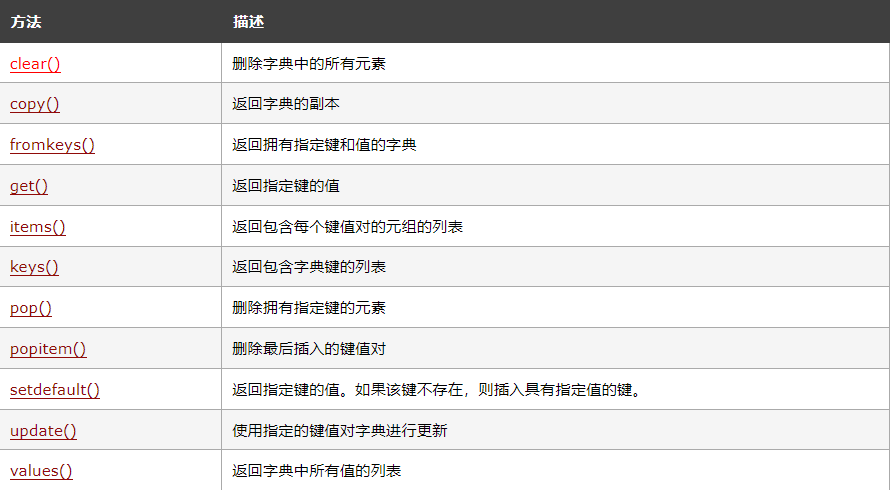您好,登錄后才能下訂單哦!
您好,登錄后才能下訂單哦!
這篇“Python的字典是什么及怎么創建”文章的知識點大部分人都不太理解,所以小編給大家總結了以下內容,內容詳細,步驟清晰,具有一定的借鑒價值,希望大家閱讀完這篇文章能有所收獲,下面我們一起來看看這篇“Python的字典是什么及怎么創建”文章吧。
字典是一個無序、可變和有索引的集合。在 Python 中,字典用花括號編寫,擁有鍵和值。
實例
創建并打印字典:
thisdict = {
"brand": "Porsche",
"model": "911",
"year": 1963
}
print(thisdict)運行實例

您可以通過在方括號內引用其鍵名來訪問字典的項目:
實例
獲取 “model” 鍵的值:
x = thisdict["model"]
運行實例

還有一個名為 get() 的方法會給你相同的結果:
實例
獲取 “model” 鍵的值:
x = thisdict.get("model")運行實例

您可以通過引用其鍵名來更改特定項的值:
實例
把 “year” 改為 2019:
thisdict = {
"brand": "Porsche",
"model": "911",
"year": 1963
}
thisdict["year"] = 2019運行實例

您可以使用 for 循環遍歷字典。
循環遍歷字典時,返回值是字典的鍵,但也有返回值的方法。
實例
逐個打印字典中的所有鍵名:
for x in thisdict: print(x)
運行實例

實例
逐個打印字典中的所有值:
for x in thisdict: print(thisdict[x])
運行實例

實例
還可以使用 values() 函數返回字典的值:
for x in thisdict.values(): print(x)
運行實例

實例
通過使用 items() 函數遍歷鍵和值:
for x, y in thisdict.items(): print(x, y)
運行實例

要確定字典中是否存在指定的鍵,請使用 in 關鍵字:
實例
檢查字典中是否存在 “model”:
thisdict = {
"brand": "Porsche",
"model": "911",
"year": 1963
}
if "model" in thisdict:
print("Yes, 'model' is one of the keys in the thisdict dictionary")運行實例

要確定字典有多少項目(鍵值對),請使用 len() 方法。
實例
打印字典中的項目數:
print(len(thisdict))
運行實例

添加項目
通過使用新的索引鍵并為其賦值,可以將項目添加到字典中:
實例
thisdict = {
"brand": "Porsche",
"model": "911",
"year": 1963
}
thisdict["color"] = "red"
print(thisdict)運行實例

有幾種方法可以從字典中刪除項目:
實例
pop() 方法刪除具有指定鍵名的項:
thisdict = {
"brand": "Porsche",
"model": "911",
"year": 1963
}
thisdict.pop("model")
print(thisdict)運行實例

實例
popitem() 方法刪除最后插入的項目(在 3.7 之前的版本中,刪除隨機項目):
thisdict = {
"brand": "Porsche",
"model": "911",
"year": 1963
}
thisdict.popitem()
print(thisdict)運行實例

實例
del 關鍵字刪除具有指定鍵名的項目:
thisdict = {
"brand": "Porsche",
"model": "911",
"year": 1963
}
del thisdict["model"]
print(thisdict)運行實例

實例
del 關鍵字也可以完全刪除字典:
thisdict = {
"brand": "Porsche",
"model": "911",
"year": 1963
}
del thisdict
print(thisdict) #this 會導致錯誤,因為 "thisdict" 不再存在。運行實例

實例
clear() 關鍵字清空字典:
thisdict = {
"brand": "Porsche",
"model": "911",
"year": 1963
}
thisdict.clear()
print(thisdict)運行實例

您不能通過鍵入 dict2 = dict1 來復制字典,因為:dict2 只是對 dict1 的引用,而 dict1 中的更改也將自動在 dict2 中進行。
有一些方法可以進行復制,一種方法是使用內建的字典方法 copy()。
實例
使用 copy() 方法來復制字典:
thisdict = {
"brand": "Porsche",
"model": "911",
"year": 1963
}
mydict = thisdict.copy()
print(mydict)運行實例

制作副本的另一種方法是使用內建方法 dict()。
實例
使用 dict() 方法創建字典的副本:
thisdict = {
"brand": "Porsche",
"model": "911",
"year": 1963
}
mydict = dict(thisdict)
print(mydict)運行實例

詞典也可以包含許多詞典,這被稱為嵌套詞典。
實例
創建包含三個字典的字典:
myfamily = {
"child1" : {
"name" : "Phoebe Adele",
"year" : 2002
},
"child2" : {
"name" : "Jennifer Katharine",
"year" : 1996
},
"child3" : {
"name" : "Rory John",
"year" : 1999
}
}運行實例
{'child1': {'name': 'Phoebe Adele', 'year': 2002}, 'child2': {'name': 'Jennifer Katharine', 'year': 1996}, 'child3': {'name': 'Rory John', 'year': 1999}}或者,如果您想嵌套三個已經作為字典存在的字典:
實例
創建三個字典,然后創建一個包含其他三個字典的字典:
child1 = {
"name" : "Phoebe Adele",
"year" : 2002
}
child2 = {
"name" : "Jennifer Katharine",
"year" : 1996
}
child3 = {
"name" : "Rory John",
"year" : 1999
}
myfamily = {
"child1" : child1,
"child2" : child2,
"child3" : child3
}運行實例
{'child1': {'name': 'Phoebe Adele', 'year': 2002}, 'child2': {'name': 'Jennifer Katharine', 'year': 1996}, 'child3': {'name': 'Rory John', 'year': 1999}}也可以使用 dict() 構造函數創建新的字典:
實例
thisdict = dict(brand="Porsche", model="911", year=1963) # 請注意,關鍵字不是字符串字面量 # 請注意,使用了等號而不是冒號來賦值 print(thisdict)
運行實例

Python 提供一組可以在字典上使用的內建方法。

以上就是關于“Python的字典是什么及怎么創建”這篇文章的內容,相信大家都有了一定的了解,希望小編分享的內容對大家有幫助,若想了解更多相關的知識內容,請關注億速云行業資訊頻道。
免責聲明:本站發布的內容(圖片、視頻和文字)以原創、轉載和分享為主,文章觀點不代表本網站立場,如果涉及侵權請聯系站長郵箱:is@yisu.com進行舉報,并提供相關證據,一經查實,將立刻刪除涉嫌侵權內容。